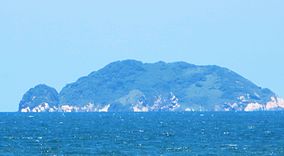Ilhas dos Currais Marine National Park
| Ilhas dos Currais Marine National Park | |
|---|---|
| Parque Nacional Marinho das Ilhas dos Currais | |
|
IUCN category II (national park)
|
|

Ilha dos Currais from Costa Azul Beach, Matinhos, 12 kilometres (7.5 mi) away
|
|
| Nearest city | Pontal do Paraná, Paraná |
| Coordinates | 25°44′09″S 48°21′55″W / 25.735833°S 48.365278°WCoordinates: 25°44′09″S 48°21′55″W / 25.735833°S 48.365278°W |
| Area | 1,359.70 hectares (3,359.9 acres) |
| Designation | National park |
| Created | 20 June 2013 |
| Administrator | Chico Mendes Institute for Biodiversity Conservation |
The Ilhas dos Currais Marine National Park (Portuguese: Parque Nacional Marinho das Ilhas dos Currais) is a national park in the state of Paraná, Brazil. It protects an important nesting site for birds, and is a refuge and feeding ground for fish including two endangered species of grouper. It may be visited for diving, but visitors must be careful to avoid any impact on the environment.
The Ilhas dos Currais Marine National Park is in the municipality of Pontal do Paraná in the state of Paraná. It has an area of 1,359.70 hectares (3,359.9 acres). The Ilhas dos Currais archipelago consists of the islands of Grapirá, Três Picos and Filhote. The archipelago is offshore in the Atlantic between Guaratuba Bay and Paranaguá Bay, 6.2 miles (10.0 km) from the coast opposite the Praia de Leste (East Beach) of Pontal do Paraná. The three small islands have rocky headlands that rise from the sea without beaches.
The islands are home to an estimated 8,000 birds. Studies by the Centre of Sea Studies of the Federal University of Paraná almost twenty years before the reserve was formed showed the great importance of the islands for the brown booby (Sula leucogaster) and magnificent frigatebird (Fregata magnificens), which reproduce around the year. The islands are also used seasonally by the kelp gull (Larus dominicanus), black-crowned night heron (Nycticorax nycticorax) and great egret (Ardea alba), and in some years by the South American tern (Sterna hirundinacea).
About 44 fish species use the waters around the island for food and refuge, including the endangered dusky grouper (Mycteroperca marginata) and Atlantic goliath grouper (Epinephelus itajara). Conservation of fish stocks around the island should benefit artisan fishermen who fish in the vicinity of the archipelago. Visibility in the water is from 0 to 10 metres (0 to 33 ft). The environment is threatened by over-fishing and excessive visits, so divers must be careful not to affect the ecosystem.
...
Wikipedia

